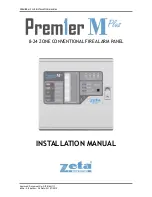
PREMIER M PLUS INSTALLATION MANUAL
Approved Document No: GLT.MAN-111
PAGE
14
Issue : 2.8 Author: NJ Date: 23/07/2012
10. GENERAL FAULT FINDING
10.1 ZONE FAULTS
The Zone Faults are non-latching faults. That is, if the fault has been cleared, the panel will automatically reset itself.
Open circuit faults will be indicated by zone(s) fault LED being lit steady, the internal Fault Buzzer will sound and the General Fault
LED will be lit.
Short circuit faults will be indicated by zone(s) fault LED and the short circuit LED Flashing, the internal Fault Buzzer will sound and
the General Fault LED will be lit.
Suggested Action
a)
Check that the correct end of line device has been fitted (1N4002 Diode)
b)
Check that the End Of line is fitted the correct way (with Cathode Stripe to zone +ve)
c)
Disconnect the wiring for the zone showing fault, and refit the end of line diode at that zone terminal in the panel. If the
fault condition for that zone clears, this confirms there is a wiring fault.
d)
Double-check the wiring and the end of line diode on the zone. Trace the fault with consideration for the type of fault
indicated.(HINT: splitting the cable half way down the zone, and fitting the end of line diode to the new end point helps to
determine which section of cable is giving the fault)
Note: A possible fault is a detector head badly seated in a base that is not making a good connection.
c)
A short circuit on a zone could be caused by the end of line diode being fitted backwards.
d)
Check that the detectors are compatible with this FACP. Note that some makes of detector will require a series resistor or
diode to be fitted to work properly. There is usually a spare connector on the base to accommodate this (check
instructions that came with the detector).
e)
Measure the resistance of the zone cabling (Remove from panel and short out end of line). Ideally this should be less than
50 ohms. Above 70 ohms may cause an open circuit fault.
10.2 SYSTEM FAULT
A system fault is an abnormal microprocessor running condition due to various unexpected phenomena.
This will result in the panel attempting to correct itself. Should this fault occur, the System Fault LED, General Fault LED, General
Fault relay and fault internal buzzer will be constantly active until the control keyswitch is turned from off position to control enable
position. This should cause this fault condition to reset. If not, consult your supplier.
10.3 SUPPLY FAULTS
A power supply fault is indicative of one or more of the following faults: -
1.
Loss of Mains power – Remedy
a)
Check mains fuse (in fused mains filter). Also, check that mains power is present.
b)
Check 24V Supply fuse on PSU board FS1 & FS2.
c)
Check 28V supply fuse on Termination Board (FS9)
2.
Loss of Battery power – Remedy
a)
Check battery fuse in battery link wire.
b)
Check that battery connections are secure.
3.
Low Battery – Remedy
a)
Check battery voltage – replace if necessary.
4.
Wrong Charging Voltage.
The charging voltage should be 27.6 V off load at 25oC. (Note that the PSU will turn off the charger voltage when the batteries are
disconnected)
5.
Battery High internal resistance.
In accordance with EN54-4, the power supply will monitor the batteries internal resistance. It will report a fault if the internal






















